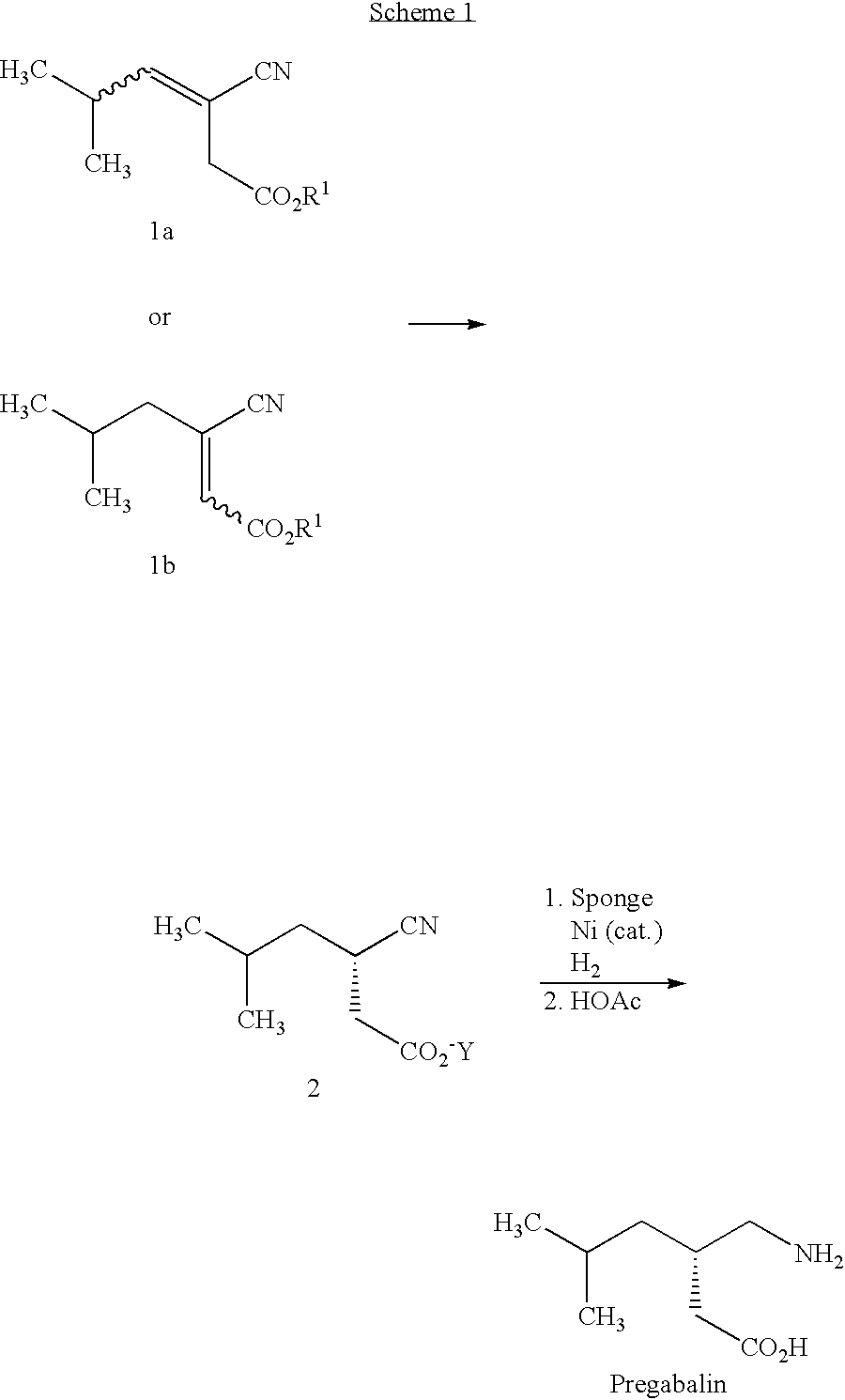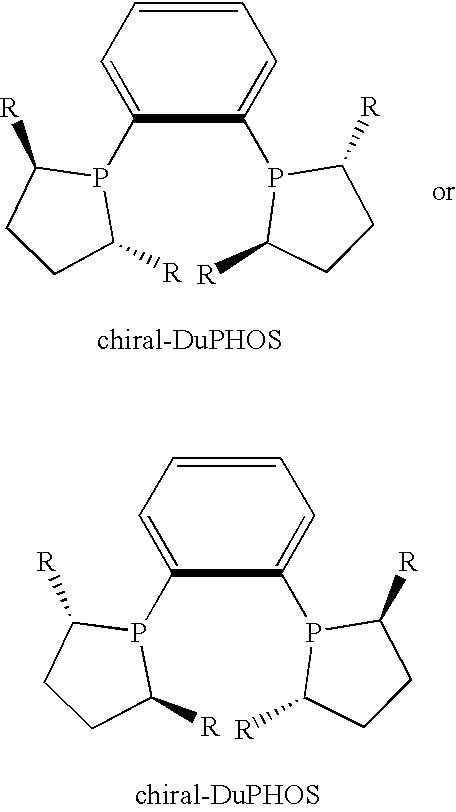Asymmetric synthesis of pregabalin
a technology of asymmetric synthesis and pregabalin, which is applied in the direction of carboxylic acid nitrile preparation, organic chemistry, drug compositions, etc., can solve the problems of significant processing, unfavorable synthesis of pregabalin, and potential unstable nitro compounds, so as to minimize the waste of the process and remove the undesired r-enantiomer.
- Summary
- Abstract
- Description
- Claims
- Application Information
AI Technical Summary
Benefits of technology
Problems solved by technology
Method used
Image
Examples
example 1
Synthesis of 3-cyano-5-methylhex-3-enoic acid salts
[0039]
A. tert-Butylammonium salt of 3-cyano-5-methylhex-3-enoic acidMaterialMWtQuantitymmolEthyl 3-cyano-5-methylhex-3-enoate181.2420.02 g110LiOH H2O41.96 13.0 g310Tetrahydrofuran 75 mLWater 25 mLHydrochloric Acid (2N)As requiredEthyl AcetateAs requiredtert-butylamine73.14 9.27 g127
[0040]Ethyl 3-cyano-5-methylhex-3-enoate (mixture of E and Z isomers) and lithium hydroxide hydrate are suspended in a mixture of tetrahydrofuran and water. The slurry is vigorously stirred for 4 hours at room temperature. The mixture is acidified to pH 2 (3N HCl) and extracted into ethyl acetate (3×150 mL). The combined organic layers are dried (MgSO4), and the solvent is removed in vacuo to give crude 3-cyano-5-methylhex-3-enoic acid. The crude acid is dissolved in ethyl acetate (400 mL), and a solution of tert-butylamine in ethyl acetate (20 mL) is added. The temperature of the solution rises approximately 10° C. as a mass of white crystalline solid ...
example 2
Asymmetric Hydrogenation of 3-cyano-5-methylhex-3-enoic acid salts
[0044]
A. tert-Butylammonium salt of (S)-3-cyano-5-methylhexanoic acidMaterialMWtQuantitymmoltert-Butylammonium salt of 3-cyano-226.3319.0 g845-methylhex-3-enoic acid[(R,R)-MeDuPHOS]Rh(COD) BF4−60449.6 mg0.082Methanol32 200 mLHydrogen2 44 psi (3 bar)
[0045]A round-bottom flask is charged with the tert-butylammonium salt of 3-cyano-5-methylhex-3-enoic acid (from Example 1A) and [(R,R)-MeDuPHOS]Rh(COD)+BF4− under a nitrogen atmosphere. Deoxygenated methanol is added via syringe, and the solution is deoxygenated by repeated partial evacuation and back filling with nitrogen. A 600 mL PARR pressure vessel is purged with hydrogen by pressurizing and releasing the pressure three times. The vessel is then heated to 55° C. The solution of substrate and catalyst is transferred to the reactor by cannula, and the vessel is again purged with hydrogen before finally pressurizing to 3 bar (44 psi). Stirring is started and hydrogen up-...
example 3
[0054]
Hydrogenation of ethyl 3-cyano-5-methylhex-3-enoateMaterialMWtQuantitymmolEthyl 3-cyano-5-methylhex-3-enoate1810.36g2.00[(R,R)-Me-DuPHOS]Rh(COD) BF4−6041.2mg2 ×10−3Methanol5mLHydrogen60 psi(4 bar)
[0055]A. The reaction is carried out in a 50 mL micro reactor fitted with an injection septum and valve. A micro reactor is used in conjunction with a glass liner. Methanol is deoxygenated by four cycles of partial evacuation and refilling with nitrogen while stirring. A liner charged with ethyl 3-cyano-5-methylhex-3-enoate and a magnetic stir bar is placed in the micro reactor, and the micro reactor is subsequently assembled. A hydrogen atmosphere is established by three cycles of charging the vessel with hydrogen and releasing the pressure. Methanol (4 mL) is added, and the vessel is then placed in an oil bath on a stirrer hotplate at 60° C. and allowed to come to thermal equilibrium (internal temp ˜45° C.). A small Schlenk tube is charged with [(RR)-Me-DuPHOS]Rh(COD)+BF4− and a nit...
PUM
| Property | Measurement | Unit |
|---|---|---|
| Fraction | aaaaa | aaaaa |
| Angle | aaaaa | aaaaa |
| Angle | aaaaa | aaaaa |
Abstract
Description
Claims
Application Information
 Login to View More
Login to View More - R&D
- Intellectual Property
- Life Sciences
- Materials
- Tech Scout
- Unparalleled Data Quality
- Higher Quality Content
- 60% Fewer Hallucinations
Browse by: Latest US Patents, China's latest patents, Technical Efficacy Thesaurus, Application Domain, Technology Topic, Popular Technical Reports.
© 2025 PatSnap. All rights reserved.Legal|Privacy policy|Modern Slavery Act Transparency Statement|Sitemap|About US| Contact US: help@patsnap.com



